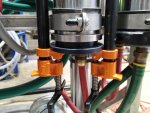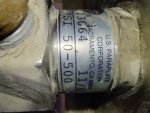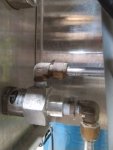Car Wash Forum
You are using an out of date browser. It may not display this or other websites correctly.
You should upgrade or use an alternative browser.
You should upgrade or use an alternative browser.
Upgrading an RO system
- Thread starter OurTown
- Start date
This thread has got me thinking. I wonder if I've been running my unit at less than an "efficient" mode.
I had a 1 membrane Applied Membranes unit that was expanded to 2 membranes decades ago (when I added an additional automatic bay). The motor/pump was also up-sized.
I've been running the Product and Reject flows equally.
If I understand things....this is a 50% recovery rate....Correct?
Per my earlier post, I'm now running XLE (Extra Low Engery) membranes at 100psi.
Today, I readjusted the flow settings to achieve a 4.0 gpm Product and a 1.5 gpm Reject flowrate. The recirculation flow is 2.5 gpm.
Am I doing the math correctly and I now have a 73% recovery rate? (4.0 divided by 5.5)
And.....this rate is OK?
It sure saves dumping water down the drain if true............
I had a 1 membrane Applied Membranes unit that was expanded to 2 membranes decades ago (when I added an additional automatic bay). The motor/pump was also up-sized.
I've been running the Product and Reject flows equally.
If I understand things....this is a 50% recovery rate....Correct?
Per my earlier post, I'm now running XLE (Extra Low Engery) membranes at 100psi.
Today, I readjusted the flow settings to achieve a 4.0 gpm Product and a 1.5 gpm Reject flowrate. The recirculation flow is 2.5 gpm.
Am I doing the math correctly and I now have a 73% recovery rate? (4.0 divided by 5.5)
And.....this rate is OK?
It sure saves dumping water down the drain if true............
OurTown
Well-known member
This thread has got me thinking. I wonder if I've been running my unit at less than an "efficient" mode.
I had a 1 membrane Applied Membranes unit that was expanded to 2 membranes decades ago (when I added an additional automatic bay). The motor/pump was also up-sized.
I've been running the Product and Reject flows equally.
If I understand things....this is a 50% recovery rate....Correct?
Per my earlier post, I'm now running XLE (Extra Low Engery) membranes at 100psi.
Today, I readjusted the flow settings to achieve a 4.0 gpm Product and a 1.5 gpm Reject flowrate. The recirculation flow is 2.5 gpm.
Am I doing the math correctly and I now have a 73% recovery rate? (4.0 divided by 5.5)
And.....this rate is OK?
It sure saves dumping water down the drain if true............
I was told by several others year ago that I should run close to a 1:1 but favoring just a tad bit more on the reject water. With the reject all the way cranked down I can just barely get a little more product water than reject. Maybe it's designed that way?
When mine was installed they told me it is best to keep the product and reject equal. You can turn the reject down but that will shorten the life of the membranes.This thread has got me thinking. I wonder if I've been running my unit at less than an "efficient" mode.
I had a 1 membrane Applied Membranes unit that was expanded to 2 membranes decades ago (when I added an additional automatic bay). The motor/pump was also up-sized.
I've been running the Product and Reject flows equally.
If I understand things....this is a 50% recovery rate....Correct?
Per my earlier post, I'm now running XLE (Extra Low Engery) membranes at 100psi.
Today, I readjusted the flow settings to achieve a 4.0 gpm Product and a 1.5 gpm Reject flowrate. The recirculation flow is 2.5 gpm.
Am I doing the math correctly and I now have a 73% recovery rate? (4.0 divided by 5.5)
And.....this rate is OK?
It sure saves dumping water down the drain if true............
OurTown
Well-known member
I turned it back on today and the best I can get now is 3.3 GPM product and 3.4 reject. The pressure regulator appears to be seized inside. I can crank the screw all the way in or out and doesn't seem to change the pressure. Right now it's about 180 psi. The tag on the pump says 250 psi max and 16 GPM. The regulator is a US Para Plate 13064 but can't find one on the innerwebs. The closest I found is one at KR but has a high pressure range.
https://www.kleen-ritecorp.com/p-17...d-back-pressure-regulator-1000-psi-8-gpm.aspx
https://www.kleen-ritecorp.com/p-17...d-back-pressure-regulator-1000-psi-8-gpm.aspx
Dan kamsickas
GinSan Technician
What is the GPM of the pump? Typically the pump is a 10GPM for two membranes with a 7gpm flow control on the output.
Ideal is 1:1 you can turn up the recirculation but it will shorten the life of your membranesI still a little confused.
Is it best to run a 1:1 product:reject rate (50% recovery), or is it OK to turn up the recirculation and have a 75% (or higher) recovery rate?
OurTown
Well-known member
What is the GPM of the pump? Typically the pump is a 10GPM for two membranes with a 7gpm flow control on the output.
250 psi max and 16 GPM on ours.
Buckeye Hydro
Active member
The ratio of permeate to concentrate is affected in a big way by the quality of your feedwater. Let's start there. Is your feedwater less than 1 gpg hardness?
Buckeye Hydro
Active member
Minimum recommended concentrate flow on a 4" diameter membrane or series of 4" membranes is 3 gpm.
OurTown
Well-known member
The ratio of permeate to concentrate is affected in a big way by the quality of your feedwater. Let's start there. Is your feedwater less than 1 gpg hardness?
Yes.
Buckeye Hydro
Active member
Assuming you have them plumbed in series, go no lower than 3 gpm on the concentrate, and if you're at membrane spec pressure and temperature, you should be at about 2500x3=7500/1440=5.2 gpm permeate. adjust this equation if the membranes aren't 2500 gpd, and for your pressure and temperature.
OurTown
Well-known member
Assuming you have them plumbed in series, go no lower than 3 gpm on the concentrate, and if you're at membrane spec pressure and temperature, you should be at about 2500x3=7500/1440=5.2 gpm permeate. adjust this equation if the membranes aren't 2500 gpd, and for your pressure and temperature.
https://www.dupont.com/content/dam/...O-4040-and-TW30-PRO-2540-PDS-45-D03971-en.pdf
Two are plumbed in series and one in parallel to those. Is that not correct?
Buckeye Hydro
Active member
Certainly not typical.https://www.dupont.com/content/dam/...O-4040-and-TW30-PRO-2540-PDS-45-D03971-en.pdf
Two are plumbed in series and one in parallel to those. Is that not correct?
Ideal is 1:1 you can turn up the recirculation but it will shorten the life of your membranes
The cost of water, and more so, the sewer....is very high in my location. At some point, it's cheaper to accept the lower life of the membranes in exchange for lower operating costs. The question, is where to draw that line.
The ratio of permeate to concentrate is affected in a big way by the quality of your feedwater. Let's start there. Is your feedwater less than 1 gpg hardness?
Yes, the quality of the water here is excellent. The feedwater has 0 grains of hardness after the softeners (and it's tested daily).








